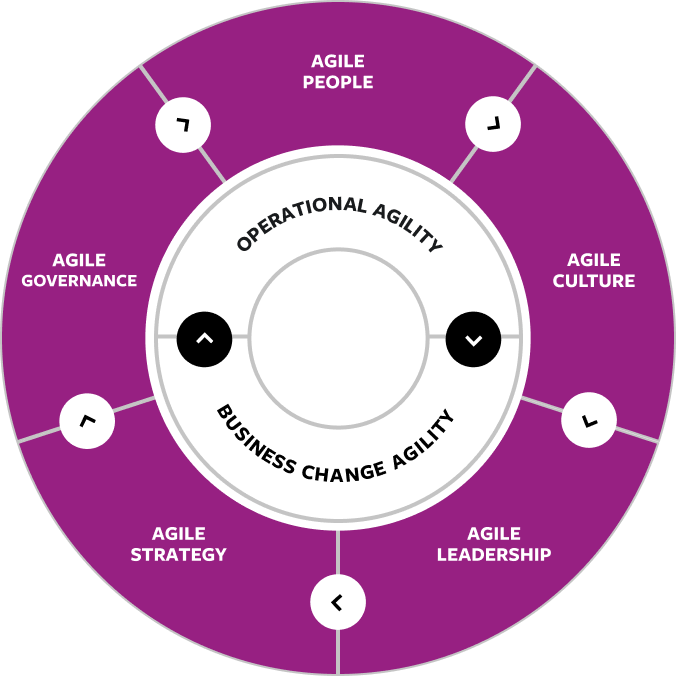The business world today can be ruthlessly tough, and many organizations are struggling to handle constant business change, and maintain a competitive advantage.
Organizations from large enterprises to small-to-medium businesses (SMBs) are discovering they need to be hyper-alert to the need to produce better products and services, decrease costs and satisfy employee and customer demands.
An agile culture is imperative if a business is to seize every emerging opportunity to thrive. In this guide, we'll explain how business leaders can create a business agility framework that can bring about design thinking and eventually form a permanent growth mindset.
Read our blog 5 priorities for business leaders in a hybrid working world
Download a PDF of our Hybrid Workplace Guide 2.0

Download a PDF of our Hybrid Workplace Guide 2.0
What is business agility?
Business agility refers to an organization's ability to adapt fast to new ideas, new technologies, changes and fluctuations in its business environment. If a business is able to respond quickly to market changes and adjust its business strategy when the need arises, it will achieve its goal of business agility.
Every successful business knows when to be flexible, and when to change path to accommodate the force of external environments. Additionally, agile practices incorporate the ability to make internal business changes when necessary.
At the heart of every agile business is customer centricity, or making customer needs and customer value a key priority. Those organizations with business agility strategies in place will be better placed to acquire new customers, and keep existing ones, allowing their business to thrive.
But business agility is not just about customers. Part of the business agility value stream means creating value for every stakeholder, employee, investor, partner, and indeed the greater community.
Core components of business agility
Before creating a business agility strategy, every business should look at the basic agile framework upon which organizational agility is based. There are three key elements within an organization that can make it truly agile: its governance, people and culture.
 Image source: Agile Business consortium
Image source: Agile Business consortium
Agile Governance
Governance is defined as the structures and processes within an organization for accountability and decision-making. Governance has an important impact on achievement of objectives, risk management, and performance optimization.
In a business world fraught with volatility, complexity, ambiguity and uncertainty, agile governance allows enterprises to thrive by building on core agile values, behaviors and practices.
 Image source: Smartsheet
Image source: Smartsheet
Agile people
The underlying philosophy of business agility prioritizes individuals and interactions over compliance with processes and tools. This places a far greater emphasis on cross functional collaboration, and liberating the collaborative creativity of people and how they work together.
Truly agile organizations are populated with people who thrive within an agile culture that's continuously enabled by agile leadership, strategy and governance.
A learning organisation is one “where people continually expand their capacity to create the results they truly desire, where new and expansive patterns of thinking are nurtured, where collective aspiration is set free, and where people are continually learning how to learn together", Peter Senge, The Fifth Discipline.
 Image source: Agile Business
Image source: Agile Business
Agile Culture
Some of the key characteristics of an agile business culture:
Flexibility: An agile approach encourages flexibility in almost every area, creating agile teams, and allowing the distribution, or sharing of problem solving responsibilities, rather than focusing on one person trying to find the best solution.
Agile work environments offer more flexible working conditions, with employees taking advantage of remote working opportunities.
Faster response times: By creating flexibility, distribution and sharing of responsibilities, an agile work environment can prioritize speed, whether in adopting new standards and practices, or addressing new issues.
Less formal structure: A true business agility value stream is dependent on leaders, rather than managers - and focuses on best practices and self organizing, rather than strict rules and formal structures dictating how work should be accomplished.
Within an enterprise agility framework, there is less documentation and procedural formality and fewer hierarchies and bureaucracies.
 Image source: Scrum alliance
Image source: Scrum alliance
How to create an agile business
To create an agile business and sustain business growth, it’s essential to balance strategy with leadership. This means knowing how to run a business while utilizing resources to create innovative business solutions.
Read our guide to creating a great workplace culture Your Ultimate Guide to Future-Proofing The Hybrid Workplace
1. Balancing strategic agility with leadership: A shared vision and purpose
Strategic agility involves developing and establishing flexible approaches to value creation throughout your business teams.
Creating transformational strategies to give your organization a shared vision and purpose enables your teams to feel emotionally and personally involved, positively impacting morale and trust in your company.
This strengthens long-term relationships between your business and your customers, employees, and potential partners. Some ways to achieve this include:
-
Soliciting buy-in from various stakeholders.
-
Using analytics tools to effectively identify new opportunities to better serve your customers.
-
Gathering customer feedback formally and informally.
Company leadership and the way it plays out is a key consideration for agile businesses. Good leaders bring clarity, provide actionable, strategic and clear, dependable guidance across the entire organization, as well as setting priorities and outcomes to make sure that all team members are thriving.
2. Empowering teams
Team members are the backbone of every business. Agility is the ability to create a dynamic workforce, and implement an agile business model. To do this, companies need to create close networks of smaller, empowered teams. For business leaders, this involves setting clear standards of transparency and alignment, expertise and accountability, and above all, collaboration.
 Image source: Medium
Image source: Medium
To effectively empower teams, effectively, it’s crucial to create a working infrastructure that focuses on the following aspects:
-
Accountability: Enabling team members to manage their roles easily, through self organization, while providing the tools for effective collaboration.
-
Prioritization: Streamlining operating systems and project management processes, facilitating decision making and innovation, and providing guidance when needed.
-
Education and Development: Encouraging teams to share knowledge and experience, and empowering them to improve their skills and capabilities.
-
Active Partnerships: Making it easier for collaboration with an internal network as well as an external environment so that companies have access to the best talent for co-developing new products and solutions.
-
An Open Virtual and Physical Environment: Creating a working environment where teams feel comfortable, inspired and motivated to do their job well. The more you empower your teams to make informed decisions, the better your business will perform.
3. Utilizing emerging technologies and resources
Agile projects require the right technology stack. Business agility is about improving flexibility and speed, and that means innovating the technologies used in product and process development.
For example, a company might decide to develop and release a minimum viable product (MVP) aimed at establishing design thinking practices and improving their means to innovate.
 Image source: Spaceo technologies
Image source: Spaceo technologies
Consumer preferences and habits have changed drastically with the advent of the digital economy. This makes it imperative that businesses seize emerging opportunities to adopt best practices and stay on top of the latest technology to keep up with dynamic market conditions.
Technology plays an important part in business process management as well as real-time communication. Inefficiencies with external and internal communication will also affect means work management systems.
Agile software development is a methodology that creates a cultural shift in many companies by focusing on the clean delivery of individual pieces or parts of software rather than the entire application. It helps software teams in an evolving landscape to visualize tasks and workflows through a board, rather than through documentation.
4. Obliterating silos
One of the key elements standing in the way of achieving business agility is silos. Without a way to connect every aspect of your business, and gain clear insights into what's going on across the entire spectrum, there is no way to create and sustain true business agility.
Without complete business integration, there is no visibility into how investments, assets, initiatives, employee performance, customer satisfaction and other aspects are connected to other parts of your business.

Deploying solutions that give you an integrated view of business units, and focusing on aligning all business areas is vital to achieving business agility.
With siloed technology, it compromises the remote and mobile components of your UC technology, devices, servers, communications platforms and all the tech that makes your organization run.
A third-party solution like IR Collaborate will break through those silos and integrate all your data.
Why real time analytics is vital for business agility
With any business agility strategy it's important that it reaches every area of an organization, from human resources, to DevOps to product management, development and budgeting. And as more and more business models shift to as-a-service models rather than one-time purchases, the need to quickly respond to customer satisfaction and communication issues is growing.
Big data is a valuable commodity, and every organization from large companies to small businesses have realized the importance of leveraging data analytics as part of their business strategy.
The most obvious benefit of real-time data analytics is that it's instant. By integrating with data collection systems like Customer Experience Management (CEMs), or Enterprise Resource Planning (ERP), you can capture huge amounts data at the source, process it and visualize it immediately.
How IR can help
To process and interpret your data, you need to consider all the applications, platforms and every operating system within your network. IR's Collaborate suite of solutions offer enterprise grade performance management, monitoring and troubleshooting, across voice, video and collaboration ecosystems.
Operating systems and communication platforms like Avaya, Cisco Webex , Zoom or Microsoft Teams, provide different analytics and monitoring solutions for each platform. This makes it even more difficult to see what's going on right across the entire picture.
Business continuity goes hand in hand with business agility. An operating system that constantly malfunctions, communication platforms that don't talk to each other, poor user experience, unsatisfactory network connections all cause interruptions to business continuity. This severely jeopardizes an organization's efficiency - and its ability to achieve business agility.
Download a PDF of our Hybrid Workplace Guide 2.0

Download a PDF of our Hybrid Workplace Guide 2.0





